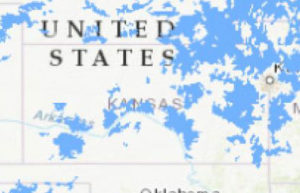Atrazine Fight Continues

Kansas Impact: If the erroneous aquatic level of concern is adopted, atrazine would be banned in the areas highlighted in blue. EPA must get the science right!
Atrazine was a topic in many of our meetings and Hill visits during Corn Congress last week. Atrazine is currently in a registration review process. While EPA says it will likely approve the registration of atrazine at current rates, it is not removing erroneous studies that would set the aquatic level of concern (LOC) for atrazine at an ultra-low 3.4 parts per billion. If that LOC was enacted now, or in the near future during the upcoming Endangered Species Act review of atrazine, it would be effectively banned from use on 44 million acres of corn in the US.
Atrazine has been in some kind of review since 1995 when EPA’s special review of the triazine herbicides began (and never truly concluded). We are nearing the finish line of a registration review for atrazine at EPA. Most recently EPA released its 2018 human health risk assessment which had some issues, but did not raise many red flags. You may remember our “Fight EPA” campaign in 2016 when we asked you to comment on the ecological risk assessment in 2016 that used studies discredited by EPA’s own science advisory panels to set an ultra low aquatic life level of concern (LOC) of 3.4 parts per billion for atrazine in untreated water (almost as low as the 3 ppb standard for drinking water). If this aquatic LOC were to be used, more than 44 million acres of corn would lose the ability to use atrazine for weed control. EPA has still not addressed our grower comments and substantive scientific comments that we submitted to the 2016 ecological risk assessment. We have been told that EPA will reregister atrazine at current application rates, but will leave in the bad studies that led to those low LOC numbers. This could be disastrous for the next regulatory step for atrazine — the Endangered Species Act review which is slated to begin in 2020. Kansas Corn is working with other states and commodities through the Triazine Network, and is telling EPA to get the science right. Stay tuned for updates on this important issue. Follow this link to learn more.
